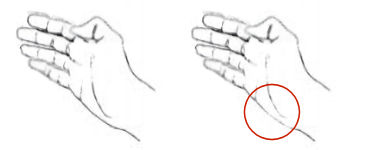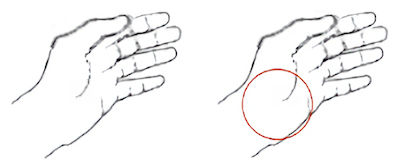Ninth Kyū – Orange Belt
What’s New for 9th Kyū?
Blah
Techniques
Bunkai
Defense
Kihon Zuki Dachi
When you are given the command to begin Kihon Zuki you should step out with your left foot into a stance about twice shoulder width.

Sanchin Dachi

Stances Beginning and Ending Kata
When you are called to attention you should stand with your heels together and your toes angled out.

When you are given the command to prepare (Yōi!) you should step to about shoulder width with your left foot. Both feet should be parallel with each other when you complete the step. This is also the stance to return to when you finish the exercise or kata. Be sure to step back with your left foot, too.

The Hand Techniques of Sanchin
Seiken
The most basic fist is seiken. Unless you are specifically told otherwise, it is the fist of choice. It is easy to make and the safest fist for beginners. The first two knuckles of the fist are the biggest and strongest. They are well-supported by the bones of the arm.

Shōken
The most basic fist is seiken. Unless you are specifically told otherwise, it is the fist of choice. It is easy to make and the safest fist for beginners. The first two knuckles of the fist are the biggest and strongest. They are well-supported by the bones of the arm.

Shutō

Uraken
The fist of uraken is make exactly the same as seiken. However, you strike with the back side of the fist. The uraken of Kanshiwa is not a punch up or out but rather a slam down. The motion is a bit like driving a nail with a hammer, but with the nose as the nail.

Boshiken

Shōte

Now is the time to begin putting moves together into combinations of block and counterattack. Visualize your opponent as you perform the combinations of your new kata, Kanshiwa.
| bunkai | 分解 | analysis |
To help you visualize the attacks of the imaginary opponent of Kanshiwa and how to respond to the attacks the instructor will demonstrate with a partner. This is called bunkai. For some students it is better to try it themselves. To prevent injuries, wait for the instructor to supervise.
Self-defense is using physical force to defend yourself against an attacker. Many students begin practicing karate to learn self-defense, but how is self-defense different from karate? Sōke Kaichō Kinjō has said that there is no such thing as self-defense. There is only karate. However, at this point in your karate training you probably do not know karate techniques well enough to defend yourself against a determined attacker.
There are self-defense techniques that have been designed to be simple enough that they can be used effectively by an inexperience defender, even those who have no karate training at all. You might be tempted to take a self-defense class, but be wary: many self-defense classes teach techniques that do not work at all or take more training than the class time allows. Ask you karate instructor to give you some pointers.
The Three A’s of Assault Prevention
Even before you take your first karate lesson you can begin to practice the three As of assault prevention.
Avoidance
Students always ask, “what if I’m walking down a dark alley late at night and someone approaches me and demands my money?” Why are you in a dark alley late at night? Avoid dark, lonely places. Don’t walk in strange neighborhoods alone. Lock your car. Lock your house, even while you are at home. Do not allow yourself to get into potentially threatening situations by carelessness.
Awareness
Be aware of your surroundings. Do not wander around with your head in the clouds, your mind on your cell phone or your ears covered by headphones.
Assurance
Victims are chosen for their apparent vulnerability. Do not look like a target. Walk with purpose and confidence. An air of assurance and physical well-being gained through karate training unconsciously sends a signal – don’t mess with me.
Fierro, Marilyn: V ictor or Victim, BuGeiSha – Traditional Martial Artist, Issue 5, 1998, p. 11-12
In Sōke Kaichō Kinjō’s experience, the immensely talented student often does not last long in the martial arts. With the ability to easily handle whatever is thrown at him or her, such a student can become complacent with their innate skill level and not make the effort to improve.
The average person, though clumsy at first, who devotes themselves with determination will grow – maybe slowly but definitely surely.
The Tortoise and the Hare
There once was a speedy hare who bragged about how fast he could run. Tired of hearing him boast, Slow and Steady, the tortoise, challenged him to a race. All the animals in the forest gathered to watch. Hare ran down the road for a while and then and paused to rest. He looked back at Slow and Steady and cried out, “How do you expect to win this race when you are walking along at your slow, slow pace?” Hare stretched himself out alongside the road and fell asleep, thinking, “There is plenty of time to relax.” Slow and Steady walked and walked. He never, ever stopped until he came to the finish line. The animals who were watching cheered so loudly for Tortoise, they woke up Hare. Hare stretched and yawned and began to run again, but it was too late. Tortoise was over the line. After that, Hare always reminded himself, “Don’t brag about your lightning pace, for Slow and Steady won the race!”
An Aesop Fable
Working With a Partner
When performing a formal exercise with a partner you should first bow to the front of the dōjō and then bow to each other. The steps are summarized below. In a less formal exercise you can skip bowing to the front of the dōjō at the beginning and end of the exercise.
Don’t worry. You will hear these commands often and will quickly learn how to respond. In the meantime, just follow along.
| The Leader Says | You Say | ||||
| Ki-o-tsuke! | 気を付け | Attention! | |||
| Rei. | 礼 | Bow. | O-negai shimasu. | お願いします。 | Please. Do me a favor. |
| O-tagai ni | お互い に | Face each other | |||
| Rei. | 礼 | Bow. | O-negai shimasu. | お願いします。 | Please. Do me a favor. |
| Yōi! | 用意 | Make ready! | |||
| Hajime! | 始め | Begin! | |||
| Yame | 止め | Stop. | |||
| Rei. | 礼 | Bow. | Arigatō gozaimasu. | ありがとう ございます。 | Thank you. |
| Shōmen ni | 正面 に | Face the front of the dōjō | |||
| Rei. | 礼 | Bow. | Arigatō gozaimasu | ありがとう ございます。 | Thank you. |
Saying Thank You
| Japanese | English |
| Arigatō. | Thanks. (informal) |
| Dōmo arigatō. | Thank you. (polite; appropriate for most situations) |
| Dōmo arigatō gozaimasu. | Thank you very much. (very polite; present tense) |
| Dōmo arigatō gozaimashita. | Thank you very much. (very polite; past tense) |
More Useful Japanese Phrases
There are many Japanese phrases used in karate class. Already you may know and understand more than these few, but these are required for 9th kyū. Most are commands that you hear over and over again in class.
| Japanese | Kanji | English |
| Ki-o-tsuke! | 気を付け | Attention! |
| Rei! | 礼 | Bow! |
| Yōi! | 用意 | Make ready! |
| Yame! | 止め | Stop! |
| O-negai shimasu. | お願いします | Please. I make a request. |
| Mawatte! | 回って | Turn! |
| O-tagai ni | お互いに | Face your partner |
| Shōmen ni | 正面に | Face the front |
| Kamaete! | 構えて | Assume ready position! [for kihon zuki] |
Names of Body Parts in Japanese
If you are in the kid’’s class (and even if you’re not), you may learn a song to help you remember the Japanese names for parts of the body. The first stanza of the song includes the following body parts:
| Japanese | Pronunciation | English |
| Atama | ah tah mah | Head |
| Kata | kah tah | Shoulders |
| Hiza | he zah | Knee |
| Ashi | ah she | Foot |
